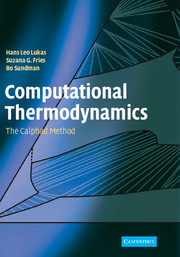Book contents
1 - Introduction
Published online by Cambridge University Press: 03 February 2011
Summary
The Calphad technique has reached maturity. It started from a vision of combining data from thermodynamics, phase diagrams, and atomistic properties such as magnetism into a unified and consistent model. It is now a powerful method in a wide field of applications where modeled Gibbs energies and derivatives thereof are used to calculate properties and simulate transformations of real multicomponent materials. Chemical potentials and the thermodynamic factor (second derivatives of the Gibbs energy) are used in diffusion simulations. The driving forces of the phases are used to simulate the evolution of microstructures on the basis of the Landau theory. In solidification simulations the fractions of solid phases and the segregation of components, as well as energies of metastable states, which are experimentally observed by carrying out rapid solidification, are used. Whenever the thermodynamic description of a system is required, the Calphad technique can be applied.
The successful use of Calphad in these applications relies on the development of multicomponent databases, which describe many different kinds of thermodynamic functions in a consistent way, all checked to be consistent with experimental data. The construction of these databases is still a very demanding task, requiring expertise and experience. There are many subjective factors involved in the decisions to be made when judging and selecting which among redundant experimental data are the most trustworthy. Even more subjective is the assessment of phases of which little or nothing is known, except perhaps in a narrow composition and temperature range.
Information
- Type
- Chapter
- Information
- Computational ThermodynamicsThe Calphad Method, pp. 1 - 6Publisher: Cambridge University PressPrint publication year: 2007
Accessibility standard: Unknown
Why this information is here
This section outlines the accessibility features of this content - including support for screen readers, full keyboard navigation and high-contrast display options. This may not be relevant for you.Accessibility Information
- 1
- Cited by
